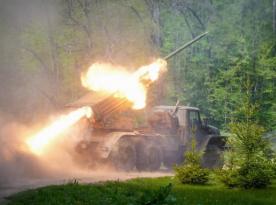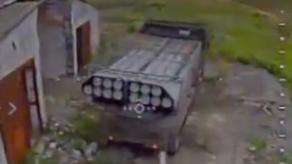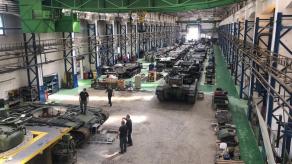Lancet loitering munition has become quite known for its active usage by russian forces in Ukraine due to the numerous videos of its application posted online. Despite the Ukrainian military being well aware of this threat, it still struggles to find an answer to this weapon.
Countering them with traditional surface-to-air missiles is complicated by various factors. Alternative measures, such as Leonidas high-power microwave or Alka laser systems are yet in their early development stages. Wire mesh, bar armor, and other passive enhancements don't guarantee safety from quite a powerful KZ-6 demolition shaped charge in Lancet's warhead.
Read more: Lancet Loitering Munition Weakness Disclosed by russians Themselves
Thus seeking "non-conventional" solutions would be reasonable in this situation. Often we hear an opinion that the progress of active protection systems will eventually eliminate the suicide drone threat for good. Theoretically, it seems to be true because such systems as Trophy, for example, potentially could deal with this task if the system got a wider field of vision
But the main problem with active protection systems is their cost because it must provide a quick response to anti-tank missiles (at least) with a very limited area of effect so as to avoid redundant fragmentation that could hurt allied infantry. To put it shortly, the system has to be state-of-art, complicated, and therefore expensive.
When dealing with a suicide drone, the bar of requirements from a protection system is lowered. moreover, there is an issue of priority: which objects should be protected first. Objectively, artillery systems are the first in the line to get this additional safety since most of the time they operate from stationary positions.

And here we should turn to another branch of development that ultimately did not become widely utilized – the anti-helicopter mines. The sketches date back to the 1970s, the United States developed the project called Self-Initiated Anti-Aircraft Missile (SIAM), followed by own research by the Bulgarian Institute of Metal Sciences and the Austrian Hirtenberger, respectively.
The Bulgarian effort resulted in the AHM-200 (anti-helicopter mine) series. All the products of this family use common principles and systems. The mine consists of a constantly working acoustic sensor that triggers when hears the sound of a rotor, turns on quite a primitive radar, and once the target gets close enough, the warhead fires either an explosively formed penetrator.
The AHM-200-1 fires only one projectile while the AHM-200-2 sends flying several in multiple directions in an attempt to compensate for low accuracy. The most advanced system that couldn't manage to go further than a concept was the 4AHM-200-100, it consisted of several charges connected to a single sensor which enabled protection of a particular area. In other words, the development progressed toward increasing the area of effect.

The Austrian weapon from Hirtenberger applied basically the same idea. The system named Helker had an acoustic sensor, too, but paired with an infrared one. Once both sound and heat signature are caught, the warhead triggers. It is more of a directional anti-personnel mine but with a range of 150 meters (almost 500 feet), guaranteed penetration of 2mm steel armor. The fragmentation reached 500 meters high.

Besides Bulgaria and Austria, the russian federation wields such mines. there is data about the existence of the PVM landmine, probably the name was updated to Bumerang as was presented in the media. The system relies on the Bulgarian concept with a shaped charge.

The difference is, the russian device can turn its warhead 360° and uses a combination of acoustic and IR sensors. According to the available data, the development was adopted by the russian military in 2012 but there is no reliable data about it ever being used. A similar principle was adopted by the Polish IMZR-11 mine developed by WZU.

The reasons why these systems found no popularity were quite banal. The mine was too expensive because it needed a proper level of accuracy, and the mined area posed a threat to allied helicopters as well. Furthermore, the attack range of modern helicopters is large enough to never approach the enemy positions as close as to fly above them. Even if that somehow happened, an ordinary MANPADS would be enough.
But suicide drones change the rules of modern warfare. So the previously inefficient weapons could be reconsidered and prove effective in the new environment, although not without necessary adjustments. first of all, it must be a cheap, device, quick in emplacement and displacement. The Bulgarian concept of 4AHM-200-100 looks the most promising because the priciest component with sensors and the fire control unit keeps working even after the system is activated.

Also, their acoustic detector could be disposed of since there is no need to keep the autonomous protection up for days (15 to 35 days, to be exact) straight. The EFP warhead is a bad idea, too, because it's more effective and easier to hit a drone with fragmentation, like in the Austrian Helker.
However, the sensor remains the main and most complicated issue. It has to be capable of identifying a suicide drone and activating the warhead. A small-sized radar would increase the cost, for one thing; and an infrared, or rather a full-fledged thermal imaging system with the necessary sensitivity for detecting a UAV would not make it cheap either.
In this situation, there are not many options left but a contrast seeker, which would monitor a designated sector, automatically recognize a suicide drone (not confuse it with a bird), and send a command to trigger the warhead when the target enters the affected area.

The good news is that contour recognition systems have improved enough for these tasks. Lastly, the manual control option should not be ruled out. Though it would require assigned observers, of course.
Additionally, due to the warhead being directed upward, such a landmine would be safer for allied personnel and equipment, although the zone of planting should be restricted anyway.

Read more: Lancet Loitering Munition Production to Increase in russia, Ukraine's Already Looking For Countermeasures














